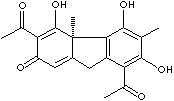PRODUCT IDENTIFICATION

H.S. CODE
TOXICITY
SMILES
CLASSIFICATION
Benzofuran, Polycyclic phenolic compound, Preservative, Cosmetic Ingredient. Biochemical ex Plants
PHYSICAL AND CHEMICAL PROPERTIES
201 - 203 C
AUTOIGNITION
NFPA RATINGS
REFRACTIVE INDEX
Stable under ordinary conditions
GENERAL DESCRIPTION & EXTERNAL LINKS
|
Product |
CAS # |
| Usnic acid | 125-46-2 11024-93-4 17669-01-1 21987-06-4 596-41-8 |
| (-)-Usnic acid | 6159-66-6 |
| (+)-Usnic acid | 7562-61-0 |
| Usnic acid sodium salt | 39012-86-7 |
Wikipedia Linking:http://en.wikipedia.org/wiki/Usnic_acid
http://ntp.niehs.nih.gov
.....A
highly purified form of usnic acid isolated from genus Usnea is
commercially available. It is also prepared in tissue culture using
tiny segments of thalli from Usnea and Ramalina species. In its
purified form, usnic acid has been formulated into creams, toothpaste,
mouthwash, deodorants, antibiotic ointments and sunscreen products.
Usnea barbata. usnic acid, and copper usnate have been produced
as antimicrobial preparations. In Germany, lichen extracts used
in cosmetics and pharmaceuticals are marketed under trade names
Omnigran a, Granobil, and Usnagren A and T (Reynolds 2000). In Italy,
usnic acid has been used in vaginal creams, foot creams, powders,
and hair shampoo (Rafanelli et al. 1995). In Argentina, "Barba
della Piedra (Usnea densirostra) has been sold to treat many ailments
(Correch et al. 1998). In these preparations, usnic acid is employed
as an active agent as well as a preservative. The extracts of lichens
rich in usnic acid have been utilized in pharmaceuticals, perfumery,
cosmetics, and in ecological applications. It has also been indicated
that usnic acid could also be used as a biomarker to assess pollution,
as its concentration in lichens increases with the increased exposure
to toxicants. In recent years, usnic acid containing health food
supplements have been promoted as weight reduction products. BIOLOGY:A
number of biological roles such as antibiotic, antimycotic, antifeedent,
phytotoxic, photobiont regulator, and UV filter etc. have been linked
to usnic acid lichens rich in usnic acid. However, it must be mentioned
that neither of these effects have been substantiated nor formally
attributed to usnic acid......
APPEARANCE
ASSAY
201-203 C